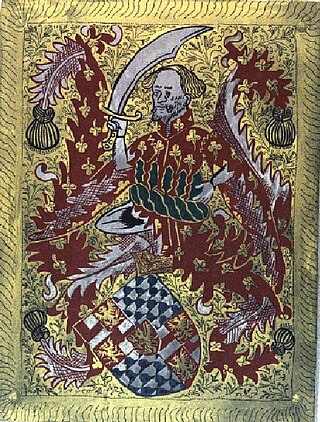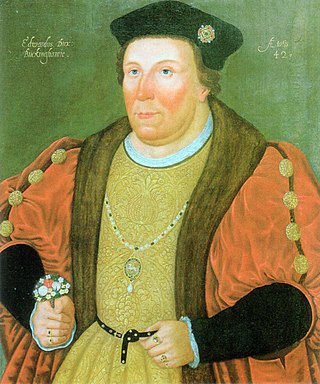
Richard Woodville, 1st Earl Rivers, also Wydeville, was the father of Elizabeth Woodville and father-in-law of Edward IV.

The Palace of Beaulieu is a former royal palace in Boreham, Essex, England, north-east of Chelmsford. The surviving part is a Grade I listed building. The property is currently occupied by New Hall School.

Humphrey Stafford, 1st Duke of Buckingham, 6th Earl of Stafford, 7th Baron Stafford, of Stafford Castle in Staffordshire, was an English nobleman and a military commander in the Hundred Years' War and the Wars of the Roses. Through his mother he had royal descent from King Edward III, his great-grandfather, and from his father, he inherited, at an early age, the earldom of Stafford. By his marriage to a daughter of Ralph, Earl of Westmorland, Humphrey was related to the powerful Neville family and to many of the leading aristocratic houses of the time. He joined the English campaign in France with King Henry V in 1420 and following Henry V's death two years later he became a councillor for the new king, the nine-month-old Henry VI. Stafford acted as a peacemaker during the partisan, factional politics of the 1430s, when Humphrey, Duke of Gloucester, vied with Cardinal Beaufort for political supremacy. Stafford also took part in the eventual arrest of Gloucester in 1447.

Edward Stafford, 3rd Duke of Buckingham was an English nobleman. He was the son of Henry Stafford, 2nd Duke of Buckingham, and Katherine Woodville, and nephew of Elizabeth Woodville and King Edward IV. Thus, Edward Stafford was a first cousin once removed of King Henry VIII. He frequently attended the courts of Henry VII and Henry VIII. He was convicted of treason and executed on 17 May 1521.

Baron Stafford, referring to the town of Stafford, is a title that has been created several times in the Peerage of England. In the 14th century, the barons of the first creation were made earls. Those of the fifth creation, in the 17th century, became first viscounts and then earls. Since 1913, the title has been held by the Fitzherbert family.

Henry Stafford, 1st Earl of Wiltshire was an English peer.

Hadlow is a village in the borough of Tonbridge and Malling in Kent, England. It is situated in the Medway valley, north-east of Tonbridge and south-west of Maidstone.

Penshurst Place is a historic building near Penshurst, Kent, 32 miles (51 km) south east of London, England. It is the ancestral home of the Sidney family, and was the birthplace of the great Elizabethan poet, courtier and soldier, Sir Philip Sidney. The original medieval house is one of the most complete surviving examples of 14th-century domestic architecture in England. Part of the house and its gardens are open for public viewing. Many TV shows and movies have been filmed at Penshurst.

Thornbury Castle is a Tudor castle in the place of Thornbury, in Gloucestershire, England, situated next to the parish church of St Mary, founded in the Norman era. Construction was begun in 1511 as a further residence for Edward Stafford, 3rd Duke of Buckingham (1478-1521), of Stafford Castle in Staffordshire. It is not a true military fortress but rather an early example of a Tudor country house, with minimal defensive attributes. As at Richmond Palace in Surrey, the main ranges of Thornbury framed courts, of which the symmetrical entrance range, with central gatehouse and octagonal corner towers, survives, together with two less regular side ranges with many irregular projecting features and towers. It is now a grade I listed building that is operated as a hotel.

Maxstoke Castle is a privately owned moated castle dating from the 14th century, situated to the north of Maxstoke in Warwickshire, England.

Thomas Grey, 2nd Marquess of Dorset was an English peer, courtier, soldier and landowner of the House of Grey.

Sandon Hall is a 19th-century country mansion, the seat of the Earl of Harrowby, at Sandon, Staffordshire, 5 miles (8.0 km) northeast of Stafford. It is a Grade II* listed building set in 400 acres (1.6 km2) of parkland.

Madeley Old Manor, was a medieval fortified manor house in the parish of Madeley, Staffordshire. It is now a ruin, with only fragments of its walls remaining. The remnants have Grade II listed building status and the site is a Scheduled Ancient Monument. The Tudor manor house is illustrated by Michael Burghers as it appeared in 1686 in Plot's History of Staffordshire, together with the formal gardens and a later east frontage. It is situated a short distance to the south of Heighley Castle, a mediaeval seat of the Audley family.

Grafton Manor was established before the Norman Conquest. Grafton means "settlement at or near the wood" and may indicate a role in woodland management within a larger estate, for instance.

Sir Richard Vernon was an English landowner, MP and speaker of the House of Commons.

Edward Littleton or Edwarde Lyttelton was a Staffordshire landowner from the extended Littleton/Lyttelton family. He also served as soldier and Member of Parliament for Staffordshire in the House of Commons of England, the lower house of the Parliament of England, five times.
Sir Henry Stafford was the second son of Humphrey Stafford, 1st Duke of Buckingham and Lady Anne Neville, daughter of Ralph de Neville, 1st Earl of Westmorland, and Lady Joan Beaufort. Henry's elder brother, also named Humphrey, died before their father, and so it was Henry's nephew, also Henry, who became the 2nd Duke of Buckingham.

Bordesley Hall was an 18th century manor house near Bordesley, Birmingham, which stood in a 15 hectare park south of the Coventry Road in an area between what is now Small Heath and Sparkbrook. The Georgian house was the successor to an earlier medieval moated manor.
Sir George Browne was an English politician. He was the eldest surviving son and heir of Sir Thomas Browne, beheaded 20 July 1460. He took part in Buckingham's rebellion, and was beheaded on Tower Hill on 4 December 1483.

Bradgate House is a 16th-century ruin in Bradgate Park, Leicestershire, England.


















